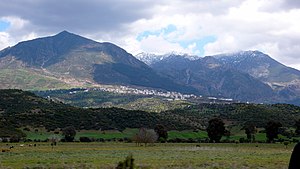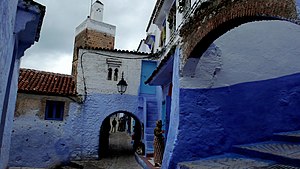Chefchaouen
| Chefchaouen | ||||
|---|---|---|---|---|
|
||||
| Basic data | ||||
| State : |
|
|||
| Region : | Tangier-Tétouan-Al Hoceïma | |||
| Province : | Chefchaouen | |||
| Coordinates | 35 ° 10 ′ N , 5 ° 16 ′ W | |||
| Residents : | 42,786 (2014) | |||
| Area : | 16.4 km² | |||
| Population density : | 2,609 inhabitants per km² | |||
| Height : | 565 m | |||
| View of Chefchaouen from the valley | ||||
Chefchaouen, Chaouen or Xauen (from the mazirischen ⴰⵛⵛⴰⵡⵏ Accawen , "caves"; arabic شفشاون, DMG romanization Šafšāw (a) n) is a northern Moroccan city with about 45,000 inhabitants in the province of the same name in the Tanger-Tétouan-Al Hoceïma region . Together with other regions of the Mediterranean, the city's traditional cuisine was recognized as an Intangible Cultural Heritage of Humanity by UNESCO in 2013 .
Surname
The name Accawen ( ⴰⵛⵛⴰⵡⵏ ) means “the horns” in Tamazight and refers to the two mountain peaks that can be seen from the city. Chaouen is a non-official short form of the city name, from which the Spanish form Xauen originated. This name appears in the documents of the Spanish protectorate of Morocco . More recently, Spanish has used the form Chauen, derived from the French form Chaouen.
Location and climate
Chefchaouen is located in the northwestern Rif Mountains at an altitude of about 560 to 600 m and about 62 km (driving distance) south of Tétouan and about 112 km southeast of Tangier . The climate is temperate to warm; Rain (880 mm / year) falls almost exclusively in the winter half-year.
Population development
| year | 1994 | 2004 | 2014 |
| Residents | 31,410 | 35,709 | 42,786 |
Most of the city's residents are Berbers; These include numerous descendants of the Moors who returned from Al-Andalus in the 15th and 16th centuries .
Economy and tourism
Chefchauen was and is one of the centers of hashish cultivation in Morocco , which is officially forbidden, but secretly still tolerated . This has attracted many Western dropouts and hippies since the 1960s , who have been followed by adventure-seeking individual travelers since the 1980s. Today, numerous group travelers (mostly people passing through or day trippers) also come to the city.
history
founding
The great mosque of Chefchaouen ( Masjid El Aadam ) was built by the city founder Moulay Ali Ben Moussa Ben Rached El Alami in 1471 ( Islamic date: 969 ). In addition to its functions as a prayer and sermon room, it also serves as a training center for Islamic religion and humanism. Moulay Ali Ben Moussa Ben Rached El Alami came from Al-Andalus to defend Morocco against the Portuguese . The year 1471 is also considered to be the year the city was founded; a small, mostly Berber population lived there at the time . The city experienced a large influx of inhabitants in 1492. Muslims and Jews expelled from Spain ( Alhambra Edict of the Catholic Kings ) immigrated. This history of immigration still shapes the architecture of the old town today: As in Andalusian villages, there are small alleys between whitewashed houses and irregular demarcations, often with shades of blue (against the evil eye ). Chefchaouen was built in a small valley and the old town extends uphill. On the heights in this direction are the springs of Ras al-Ma and the restored Jemaa Bouzafar mosque . The city center is formed by the Plaza Uta al-Hammam with the Alcazaba . The mosque of the Andalusians has only one minaret and an octagonal floor plan. The new city was built below the old town ( medina ) of Chefchaouen.
Holy city
For centuries, Chefchaouen was considered a holy city, closed to foreigners on pain of death; this has contributed to the fact that medieval architecture was preserved in it. The fact that the urban structure is changing dynamically is a new phenomenon.
Beginning of the protectorate
Spanish troops pushed through the opening of Chefchaouen when they tried to force northern Morocco under their control. A protectorate was to emerge, which was codified at the Algeciras Conference in 1906 . When the Spanish protectorate troops came to Chefchaouen, the city had a significant Sephardic Jewish population who spoke judeoespañol . Chefchaouen was the main base of the Spanish Protectorate Army. In 1956 the last Spanish flag of the Protectorate was brought down here. As in other cities in the area of the former Spanish protectorate, Castilian is still widespread in Xauen.
Abd el-Krim im custody
During the First World War, Walter Zechlin (1879–1962), consul of the German Empire in Tétouan, fueled anti-colonial efforts in French Morocco and negotiated with Mohamed Abd el-Krim . Zechlin was transferred to Madrid in 1917 and Abd el Krim was imprisoned by the Spanish security forces from 1916 to 1917; he was arrested in the Alcazaba of Chefchaouen.
Reef war
During the Rif War , Chefchaouen was completely evacuated in 1924 in preparation for the use of mustard gas . In November 1925, the Escadrille Cheériffian flight squadron , led by Charles Sweeney, a US pilot from the Lafayette Escadrille , bombed Chefchaouen. When the bombing became known, the French government under Aristide Briand and Édouard Herriot , withdrew the Escadrille Cheériffian .
Attractions
- The entire old town with its charming narrow streets, small squares, blue and whitewashed houses invites you to stroll. The blue color is supposed to protect against the evil eye .
- The Alcazaba with its garden, built from rammed earth and left in its natural color, can be visited. Its rooms house some exhibits on the history and culture of the city.
- Surroundings
- About 1.5 km outside and about 150 m above the village is the (restored) Jamaa Bouzzafer mosque , which was built during the Rifkabylen uprising and was mainly used as a hiding place and observation post. From here there are beautiful views of the city.
Town twinning
Chefchaouen has partnerships or friends with the following cities:
-
 Issaquah , USA
Issaquah , USA
-
 Vejer de la Frontera in Andalusia , ( Spain )
Vejer de la Frontera in Andalusia , ( Spain ) -
 Ronda in Andalusia , ( Spain )
Ronda in Andalusia , ( Spain ) -
 Kunming , People's Republic of China
Kunming , People's Republic of China
-
 Testour , Tunisia
Testour , Tunisia
-
 Mertola , Portugal
Mertola , Portugal
Web links
Individual evidence
- ↑ Chefchaouen, UNESCO World Heritage
- ↑ Chefchaouen - climate tables
- ^ Chefchaouen - population development
- ^ Alejandro del Valle, Jesús Verdú España y Marruecos p. 79
- ^ Weider History Group, Rif War
- ↑ www.anmp.pt








